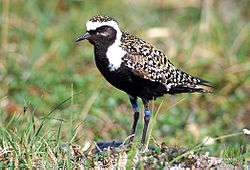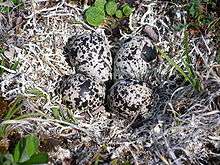American golden plover
| American golden plover | |
|---|---|
 | |
| Scientific classification | |
| Kingdom: | Animalia |
| Phylum: | Chordata |
| Class: | Aves |
| Order: | Charadriiformes |
| Family: | Charadriidae |
| Genus: | Pluvialis |
| Species: | P. dominica |
| Binomial name | |
| Pluvialis dominica (Statius Muller, 1776) | |
| Synonyms | |
|
Pluvialis dominica dominica | |
The American golden plover (Pluvialis dominica) is a medium-sized plover. The genus name is Latin and means relating to rain, from pluvia, "rain". It was believed that golden plovers flocked when rain was imminent. The species name dominica refers to Santo Domingo, now Hispaniola in the West Indies.[2]

Note dusky back and axillaries.
Description
Adults are spotted gold and black on the crown, back and wings. Their face and neck are black with a white border; they have a black breast and a dark rump. The legs are black.
It is similar to two other golden plovers, European and Pacific. The American golden plover is smaller, slimmer and relatively longer-legged than European golden plover (Pluvialis apricaria) which also has white axillary (armpit) feathers. It is more similar to Pacific golden plover (Pluvialis fulva) with which it was once considered conspecific under the name "lesser golden plover".[3] The Pacific golden plover is slimmer than the American species, has a shorter primary projection, and longer legs, and is usually yellower on the back.
Feeding and breeding
These birds forage for food on tundra, fields, beaches and tidal flats, usually by sight. They eat insects and crustaceans, also berries.

The breeding habitat of American golden plover is Arctic tundra from northern Canada and Alaska. They nest on the ground in a dry open area. They are migratory and winter in southern South America. They follow an elliptical migration path; northbound birds pass through Central America about January–April[4][5] and stage in great numbers in places like Illinois before their final push north. In fall, they take a more easterly route, flying mostly over the western Atlantic and Caribbean Sea to the wintering grounds in Patagonia. The bird has one of the longest known migratory routes of over 40,000 km (25,000 mi). Of this, 3,900 km (2,400 mi) is over open ocean where it cannot stop to feed or drink. It does this from body fat stores that it stocks up on prior to the flight. It is a regular vagrant to western Europe.
A comparison of dates and migratory patterns leads to the conclusion that Eskimo curlews and American golden plovers were the most likely shore birds to have attracted the attention of Christopher Columbus to nearby America in early October 1492, after 65 days at sea out of sight of land.[6]
Status
Large numbers were shot in the late 19th century and the population has never fully recovered.
Footnotes
- ↑ BirdLife International (2012). "Pluvialis dominica". IUCN Red List of Threatened Species. Version 2013.2. International Union for Conservation of Nature. Retrieved 26 November 2013.
- ↑ Jobling, James A (2010). The Helm Dictionary of Scientific Bird Names. London: Christopher Helm. pp. 138, 311. ISBN 978-1-4081-2501-4.
- ↑ Reviewed in Sangster et al. 2002
- ↑ Strewe & Navarro 2004
- ↑ Herrera et al. 2006
- ↑ Gollop, J.B.; Barry, T.W.; Iversen, E.H. (1986). "Eskimo Curlew - A vanishing species? : The Eskimo Curlew's Year - Introduction to Oceanic Migration". Nature Saskatchewan & United States Geological Survey. Archived from the original on 29 November 2009. Retrieved 22 December 2007.
References
- Hayman, Peter; Marchant, John; Prater, Tony. Shorebirds: An identification guide to the waders of the world. Boston: Houghton Mifflin. ISBN 0-395-60237-8.
- Herrera, Néstor; Rivera, Roberto; Ibarra Portillo, Ricardo; Rodríguez, Wilfredo (2006). "Nuevos registros para la avifauna de El Salvador" [New records for the avifauna of El Salvador] (PDF). Boletín de la Sociedad Antioqueña de Ornitología (in Spanish and English). 16 (2): 1–19.
- Sangster, George; Knox, Alan G.; Helbig, Andreas J.; Parkin, David T. (2002). "Taxonomic recommendations for European birds". Ibis. 144 (1): 153–159. doi:10.1046/j.0019-1019.2001.00026.x.
- Strewe, Ralf; Navarro, Cristobal (2004). "New and noteworthy records of birds from the Sierra Nevada de Santa Marta region, north-eastern Colombia". Bulletin of the British Ornithologists' Club. 124 (1): 38–51.
External links
| Wikimedia Commons has media related to Pluvialis dominica. |
| Wikispecies has information related to: Pluvialis dominica |
- American golden plover at ENature.com
- BirdLife species factsheet for Pluvialis dominica
- "Pluvialis dominica". Avibase.

- "American golden plover media". Internet Bird Collection.
- American golden-plover photo gallery at VIREO (Drexel University)
- American Golden-Plover species account at NeotropicalBirds (Cornell University)
- Interactive range map of Pluvialis dominica at IUCN Red List maps
- Audio recordings of American golden plover on Xeno-canto.
- Pluvialis dominica in the Flickr: Field Guide Birds of the World
- American golden plover media at ARKive

